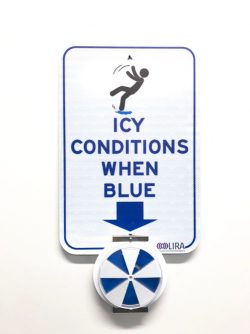This One Simple Solution Is Helping Public Entities Drastically Reduce Winter Slip and Fall Claims

Public safety is no joke. Every year, public entities are faced with a slew of general liability claims for slips, trips and falls.
“We had over 1,000 claims over the course of 5 years with an incurred value greater than $7 million,” said Tim Vincent, program manager, multi-line program at the Vermont School Board Insurance Trust (VSBIT). His team saw that winter conditions — snowy weather and icy paths — were a leading cause of their troubles.
“We evaluated a number of different options such as ice and snow removal guidelines, which we implemented, and crampons for shoes, which were not practical, yet always struggled to reduce the frequency of slips and falls on ice and snow.”
For more than 35 years, VSBIT has served a large portion of Vermont’s school districts. The team wanted to come up with a slip and fall solution, not just for the schools but also for the safety of the public.
“We wanted to implement something that raised awareness to freezing temperatures and subsequently dangerous conditions on walkways, entrances and parking lots,” said Vincent.
Why the Public Sector Is Vulnerable
“Your car warns you at 37 degrees, because icy conditions are not always obvious, even during winter,” said Marcus Henthorn, area vice president, Gallagher. It’s one explanation as to why so many slips and falls occur in the first place; people are unaware of how easily ice can lie waiting.
“More often than not, when employees or patrons slip and fall on snow and ice — it’s coming back to our clients.”
Henthorn has served public entities for as long as he’s been with Gallagher. He noted that most of his clients tend to be a part of a larger pool, which has both its advantages and setbacks when it comes to member-wide risk management.
Speaking generally, Henthorn said, “the amount of money spent on claims associated with slips, trips and falls, specifically on snow and ice, has and will continue to be a problem. Shoveling and salting sidewalks is only as dependable as the maintenance and grounds staff employed by each individual member of the pool.”
Additionally, public entities have a lot of turnover. “Leadership plays musical chairs as administrators move from one organization to the next,” said Henthorn. As new people come in, priorities can fluctuate: “A strong focus on safety can be put on the back burner as more pressing issues require immediate attention.
“It’s a cultural issue. We were looking for a solution that immediately impacted safety culture,” said Henthorn.
Icy Weather Signage
He found his answer through icy condition signage. While seemingly a small addition to overall risk management programs, these signs could be placed at every entrance and exit, alerting passersby of icy conditions. A small mechanism would change colors — from silver to blue — when temperatures dropped below 37 degrees.
“You can try to stay ahead of the conditions,” said Henthorn. “But the signs create a permanent function of awareness.”
VSBIT decided these signs were worth the test, reviewing their program and installing them at 10 of their schools.
“Those schools had 39 losses and almost $240,000 in losses the prior 5 years,” explained Vincent. “In the [first] year of implementation, those same schools had only one slip and fall in total. The feedback from member schools was all positive.”
VSBIT, which rolled out phase one over the 2017-18 season, grew its sign program after that, expanding for the 2018-19 season.
“We have since rolled it out to a total of 39 schools, and our board has given approval for further signs to be implemented next year.”
Collaboration Is Key
Seeing the success of the VSBIT in its first year, Henthorn was eager to gather more data. “The return on investment that VSBIT achieved in their pilot couldn’t be ignored,” he said. “I wanted to see additional results from a second study.”
Enter the Libraries of Illinois Risk Agency (LIRA), another one of Henthorn’s clients. Julie Milavec, director of the Downers Grove Public Library and a member of LIRA since its inception, said “winter weather seemed to cause a vast majority of claims. Slips and falls were the cause of a huge amount of accidents and claims made within the program.”
In fact, Henthorn noted, LIRA and the VSBIT both had similar slip and fall data due to winter weather despite being different programs in different states. He went to Vincent to see if he could share the results thus far.
“Collaborative efforts undertaken by pool members reduce risks and associated costs, however, those collaborations are often kept within the members of that specific pool,” explained Henthorn.
Luckily, Vincent saw it differently: “We are not in competition with these pools,” he said, “so if there is a way we can collaborate and share resources, then it exponentially increases the strength of our risk management team by being able to pull from the experience and expertise of other pools that are dealing with the same issues … It was a no brainer when Marcus brought up the topic.”
With LIRA, Henthorn didn’t hold back: He shared the successes of the VSBIT with the libraries’ liability and workers’ comp insurance carriers.
“In fact, he got the insurance carriers to pay for the first sign for each member,” said Milavec. Together, Henthorn and the carriers created a loss control grant, which guaranteed one sign for each member of LIRA going into the 2018-19 season.
Then, going one step further, Henthorn made it even easier for LIRA members to order more signs.
“I tried to design a streamlined ordering process by building it into the renewal application,” he explained. So far, LIRA is seeing great results — they haven’t had one slip or fall claim yet this winter.
“Public entities don’t compete with one another like the private sector,” Henthorn said. “Without the willingness of VSBIT to share their idea, the LIRA grant program would never exist.”
He’s already working with other clients for signage implementation for the 2019-20 winter season.
“It’s important, [as a broker], when we see a product that works, that we make every effort to deliver it to our clients. Pools are a result of innovation; we need to share ideas to address the continuing challenges our clients face in managing risk.”
It is this very philosophy on collaboration that earned Henthorn a 2019 Power Broker® designation in the Public Sector category. Henthorn is also considered a 2019 Rising Star.
“Marcus is and has been the facilitator of this collaboration amongst pools, and I strongly believe that we are all better for that effort,” added Vincent. &











